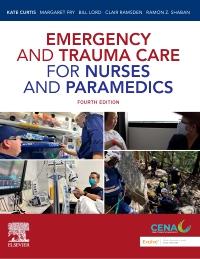
Emergency and Trauma Care for Nurses and Paramedics - E-Book, 4th Edition
Elsevier eBook on VitalSource

Now $144.89
The text spans prehospital and hospital care, enabling students to understand the patient journey and equipping them for their role in a multidisciplinary team. Coverage includes assessment, triage and management of trauma, physiology of emergency care, and the recognition and management of specific body system emergencies, as well as the fundamentals of emergency care such as quality and safety, ethics, leadership, research and patient education.
Fully revised to reflect the dynamic and evolving nature of emergency and trauma care, this book is ideal for students, prehospital care providers, rural, remote and urban emergency and trauma care nurses, and other disaster management clinicians.
-
- Endorsed by the College of Emergency Nursing Australasia
- Written by internationally recognised clinicians, researchers and leaders in emergency care
- Latest evidence-based research and practice across the emergency care continuum
- Case studies to consolidate knowledge apply theory to practice Practice tips highlight cultural considerations and communication issues
- Aligns to NSQHSS 2e, NMBA and PBA Standards
- Includes Elsevier Adaptive Quizzing for Emergency and Trauma Care for Nurses and Paramedics 4e
- Image collection
- PowerPoint slides
- Case study questions and answers
- Additional case studies with answers and rationales
- Additional paramedic case studies with answers and rationales
- Paramedic test bank
- Test bank
- Additional case studies
- Additional paramedic case studies
- Videos
-
SECTION ONE: OVERVIEW OF EMERGENCY CARE
1. Emergency nursing in Australia and Aotearoa New Zealand (p.3)
2. Paramedicine in Australia and Aotearoa New Zealand (p.19)
3. Clinical ethics for emergency healthcare (p.31)
4. Emergency care and the law (p.41)
5. Cultural considerations in emergency care (p.63)
6. Patient safety and quality in emergency care (p.75)
7. Research for emergency care (p. 89)
8. Patient and carer engagement and communication (p.109)
SECTION 2: CLINICAL CONCEPTS AND SYSTEMS
9. Scene assessment, management and rescue (p.129)
10. Physiology and pathophysiology for emergency care (p.153)
11. Clinical reasoning, problem-solving and triage (p.177)
12. Major incident preparedness and management (p.201)
13. Patient assessment and essentials of care (p.225)
14. Resuscitation (p.265)
15. Stabilisation and transfer (p.291)
16. Clinical skills (p.313)
17. Minor injury and management (p.385)
18. Pain management (p.419)
19. Organ and tissue donation (p.443)
20. End of life (p.461)
SECTION THREE: EMERGENCIES
21: Respiratory emergencies (p.475)
22. Cardiovascular emergencies (p.517)
23. Neurological emergencies (p.561)
24. Gastrointestinal emergencies (p.591)
25. Renal and genitourinary emergencies (p.633)
26. Endocrine emergencies (p.659)
27. Healthcare-associated infections and infectious diseases in emergency care (p.683)
28. Environmental emergencies (p.709)
29. Oncological and haematological emergencies (p.741)
30. Toxicological emergencies (p.771)
31. Dental, ear, nose and throat emergencies (p.793)
32. Ocular emergencies and trauma (p.817)
33. Gynaecological emergencies (p. 849)
34. Maternal emergencies (p.867)
35. Paediatric emergencies (p.893)
36. Mental health emergencies (p.973)
37. People with disabilities (p.997)
38. The older person (p.1019)
39. Violence, abuse and assault (p.1035)
40. Alcohol, tobacco and other drug use (p.1053)
SECTION FOUR: MAJOR TRAUMA
41. Epidemiology of injury (p.1093)
42. Major trauma initial assessment and management (p.1125)
43. Traumatic brain injury (p.1163)
44. Maxillofacial trauma (p.1187)
45. Thoracic and neck trauma (p.1121)
46. Abdominal and genitourinary trauma (p.1251)
47. Spinal Trauma (p.1289)
48. Major orthopaedic and neurovascular trauma (p.1317)
49. Burns trauma (p.1357)


 as described in our
as described in our 